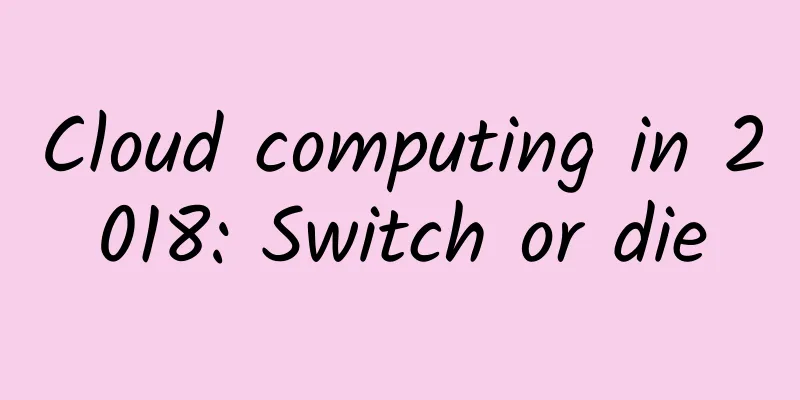Cloud computing in 2018: Switch or die

|
Cloud computing technology is creating a new and different business opportunity. New things require us to constantly learn and improve our way of operation and even our way of thinking to keep pace with the times in order to develop better. Sticking to the old ways will only lead to elimination. In other words, transform or die. That’s the powerful, no-nonsense message from Oracle Vice President Ashish Mohindroo and Fast Company co-founder and founder Bill Taylor: Traditional data centers won’t cut it anymore, it’s time to think in a new way, one that won’t replicate the complexity of on-premises deployments and implementations in the cloud.
A changing era The IT industry is currently in the midst of a tectonic shift that happens every 20 years, with the move from client/server computing to the Internet in the 1990s being replaced by a transformation to cloud computing. This seismic shift is profound and unavoidable. Nowadays, no industry can be separated from the Internet. Cloud computing technology is an innovation in the past decade. It is an optimization of the network, including artificial intelligence, machine learning, blockchain, automatic software, the Internet of Things, and improvements in human interaction interface design. A potential problem facing enterprises today is that the existing IT infrastructure and strategy are not designed to take advantage of new technologies, support new business models, or conduct adequate management and control, but to complete work quickly, which is the so-called "forcing growth". Traditional data centers are built in an isolated manner, taking into account only maximum capacity and peak load. However, as the amount of information increases and social needs increase, what is maximum capacity and peak load? They are not designed as elastic, comprehensive or flexible networks. What is more complicated is that each isolated service does not communicate with other services and may be built on different standards, which brings great difficulties to the interconnection between data centers. Therefore, no matter what kind of platform or network, the bottom layer needs to be vendor-neutral and clear: for existing enterprises, they must undergo the necessary cloud basic service transformation: data service (DaaS), software as a service (SaaS), platform as a service (PaaS) and infrastructure as a service (IaaS). These services need to be based on open technologies and standards, including SQL and NoSQL databases. Times are changing, demands are increasing, and innovation and change are needed. Six paths to cloud deployment Oracle defines six different paths to the cloud, each with different appeal:
Change the way you think IT staff and even everyone needs to expand their horizons and go beyond technology. Are you sure that what you know now will not limit your future imagination? Can you learn as fast as the world changes? Have a deep understanding of the cloud applications you use to build, or learn about each new cloud computing technology and programming language. The world is changing so fast. Looking back 20 years ago, you would never have imagined that today's network world would develop so fast! This requires constantly transforming your thinking and keeping up with the pace of the new era, new innovation, and new changes to remain invincible, otherwise you will only be eliminated by the new era! |
<<: How to attract and train talents in the era of the Internet of Things
>>: The 5G commercial era is coming, and large-scale commercial use will be achieved in 2020
Recommend
Accelerating digital transformation, 5G empowers the next generation of new industrial manufacturing
[[335662]] The COVID-19 pandemic has imposed mand...
Build telecom-grade WiFi and lay out the entrance to the wireless city?
As early as 2013, the WiFi networks of the three ...
Hot Topic | What’s so great about 5G that makes the United States tremble?
Recently, Huawei's suppression by the United ...
Global spending on 5G network infrastructure nearly doubled in 2020
According to the latest forecast from Gartner, gl...
New infrastructure, new engine: Huawei releases new generation NetEngine 8000 full-service smart router
[Nanjing, China, August 18, 2020] Today, at a pre...
How many gateways in Flowable do you know?
Gateway Gateways are used to control the flow of ...
TmhHost Hong Kong three network CN2 GIA monthly payment starts from 45 yuan, US CN2 GIA high defense VPS quarterly payment starts from 99 yuan
TmhHost is a regular domestic company with ISP\IC...
5G spectrum competition is "fighting" and deployment is surging
Recently, T-Mobile urged the FCC to complete the ...
Understand the Internet Security Protocol IPSec in 5 minutes
There are thousands of networks, but security is ...
Ten Tips to Simplify Fiber Optic Cable Installation
Installing fiber optic cable is a complex and tim...
How is vmiss? Simple test of vmiss Hong Kong VPS (CN-Hong Kong-BGP)
At the beginning of last month, we purchased the ...
Everything is connected and edge computing is intelligent
On November 30, the 2017 Edge Computing Industry ...
Huawei releases "Premium Private Line 2.0 & Intelligent Distributed Access" solution
[Beijing, China, October 15] In September this ye...
Juniper Networks 2017 Annual Conference grandly held, focusing on telecom and OTT markets
[51CTO.com original article] In February 2017, th...
5G and IoT: The mobile broadband future of IoT
5G is the fifth generation of mobile, cellular te...









